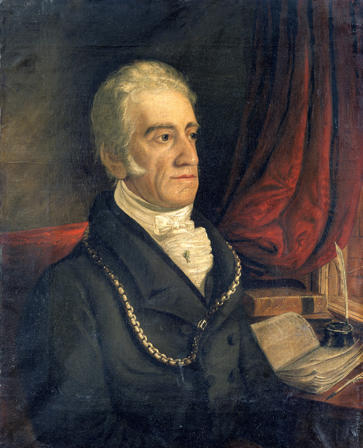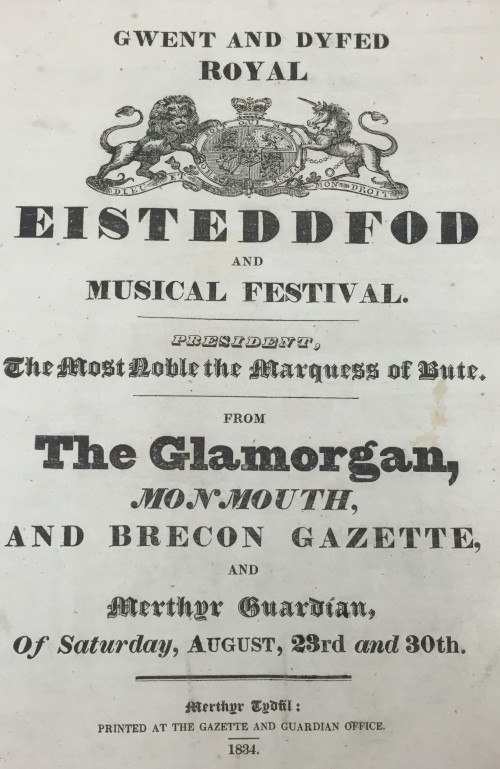This guest post comes from Vicky Shirley, a third-year PhD student in the School of English, Communication, and Philosophy. Her thesis examines the reception and re-writing of Geoffrey of Monmouth’s Historia regum Britanniae in England, Scotland, and Wales. She is currently preparing an article for publication on the reception of Geoffrey of Monmouth by Welsh and English antiquarians in the eighteenth and nineteenth centuries, and the Salisbury Library in Special Collections has been integral to her research. The Salisbury Library contains a number of classic works of Welsh medievalism, such as the The Cambrian Register and Myrvyrian Archaiology of Wales. Special Collections also holds several microfilms of manuscripts belonging to the eighteenth-century antiquarian Lewis Morris, who thought that the Brut y Tysilio was the original Welsh source of Geoffrey’s Historia Regum Britanniae, and the reception of his theory is the subject of her article.
My research for my article has recently led me to Rice Rees’ Essay on the Welsh Saints, or the Primitive Christians, which was published in 1836. Rice Rees (1804-39) was a cleric and scholar, and his essay was the winning entry in one of the essay competitions at the Gwent and Dyfed Royal Eisteddfod, which was held in Cardiff in 1834. Rice Rees’ uncle, William Jenkins Rees (1772-1855), was instrumental in re-introducing the Eisteddfod to Wales in the nineteenth century. The Gwyneddigion Society had tried to revive the annual Eisteddfod in the late eighteenth century, but they only ran between 1789 and 1794 in Bala, St. Asaph, Llanrwst, Denbigh, and Dollgellau respectively. In October 1818, several Welsh clerics antiquarians, including W. J. Rees, met in Montgomeryshire, and proposed to establish provincial societies for the study of Welsh literature in in Dyfed, Gwynedd, Gwent, and Powys. These societies were responsible for hosting eisteddfodau in their provinces, and the first one was held at Carmarthen in 1819. W. J. Rees also helped to re-establish The Honourable Society of the Cymmrodorion, and the second society (1820-43) oversaw the activities of the local Cambrian Societies.
The Gwent and Dyfed Royal Eisteddfod was held on 20th-22nd August 1834 at Cardiff Castle, by the invitation of John Crichton-Stuart, the 2nd Marquess of Bute. The young Princess Victoria and the Duchess of Kent were invited to the Eisteddfod, and several Welsh literati were also present at the event, including Lady Charlotte Guest and Taliesin Williams, the son of Edward Williams (Iolo Morganwg), who won the Bardic Chair that year. In his opening speech, the Marquess remarked that:
[t]he Eisteddfodau shew a character of good-will and harmony and kindness, joining together all persons of Celtic origin, in one bond of social attachment and literary enjoyment. They are meetings in which we are desirous to shew our forefathers; to recall to memory the history of former days; and to shew the regard that we ever cherish to our departed ancestry.[1]
Lady Charlotte Guest includes a short account of the Cardiff Eisteddfod in her journal. She did not the Marquess’ opening speech in very high regard – she preferred the oratory of William Price instead, and he eventually became one of the judges. A transcript of both speeches was included in the report of the Gwent and Royal Eisteddfod, which was printed by The Glamorgan, Monmouth and Brecon Gazette and Merthyr Guardian.
In his essay, Rees provides an ‘ecclesiastical history of the Britons, from the introduction of Christianity, or more especially from the termination of Roman power in Britain, to the end of the seventh century’.[2] The scope of Rees’ narrative is similar to Geoffrey of Monmouth’s Historia regum Britanniae, which describes the history of Britain from its foundation by Brutus of Troy to the death of Cadwalladr, the last king of the Britons in 682. The two narratives correspond with each other as they use similar sources, including a variety of ancient Welsh poems, triads, and genealogies. These texts were being steadily recovered in the eighteenth and nineteenth centuries, as scholars and antiquarians began to publish many works of Welsh literature for the first time.
Despite the similarities between his essay and the Historia regum Britanniae, Rees was sceptical of Geoffrey. Like many scholars and historians, Rees thought Geoffrey was a translator, who added his own fabulous inventions to his work. In particular, Rees attacks Geoffrey for his inaccuracy, and in a section on Saint David, the patron saint of Wales, he remarks that:
Geoffrey of Monmouth states that Dewi, archbishop of Caerleon, died in the monastery which he had founded at Menevia, where he was honourably buried by order of Maelgwn Gwynedd. This event is recorded by Geoffrey as if it happened soon after the death of Arthur, who died A.D. 542. According to the computations of Archbishop Usher, St. David died A.D. 544, aged eighty two […] But it must be allowed that the dates quotes by Usher are very uncertain, and depend upon the authority of writers who lived many centuries after the events which they record. The older generations, and the names of contemporaries, rend it necessary to place the birth of David about twenty years later than it is fixed by Usher; and his life may be protracted to any period short of A. D. 566. [3]
The death of Arthur and David is one of the few dates that are mentioned in the Historia regum Britanniae, and so this point of contention is one of the few examples where Rees could directly challenge Geoffrey’s authority and undermine his chronology. Rees’ estimation that Saint David died in 566 is a little unreliable, as it is now generally accepted that he died in 589. Nevertheless, his comparison of sources is typical of the method many historians – medieval and modern – used to try and disprove the events recorded in Geoffrey’s Historia.
My interest in the Rees family began in September 2012, when I was an undergraduate research assistant on a Cardiff Undergraduates Research Opportunities Program project, which involved cataloguing provenance and marginalia in the Cardiff Rare Books collection (1660-1700). During this project, I found a number of books which were owned by different members of the Rees family. The Rees family library once had over 7,000 books, many of which were donated to the Cardiff Public Library, before they were acquired by Special Collections in 2010. My current research has given me a better understanding about how important the Rees family were to medieval scholarship and antiquarian activities in Wales during the nineteenth century.
Bibliography
Primary Sources
Guest, Lady, Lady Charlotte Guest: Extracts from her Journal, 1833-1852, ed. V. B. Ponsby, Earl of Beesborough (London: Murray, 1950)
Rees, Rice, An Essay on the Welsh Saints, or the Primitive Christians, usually considered to have been the founders of the churches in Wales (London: Longman, Rees, Orme, Brown, Green, and Longman, printed by William Rees, Llandovery, 1836)
‘Gwent and Royal Eisteddfod and Musical Festival’, The Glamorgan, Monmouth, and Brecon Gazette and Merthyr Guardian, Saturday 23rd and 30th August 1834
Secondary Sources
Ellis, Mary, ‘W. J. Rees, 1772-1855: A Portrait, Part I’ Radnorshire Society Transactions 39 (1969): 24-35
___________, ‘W. J. Rees, 1772-1855: A Portrait, Part II’ Radnorshire Society Transactions 40 (1970): 21-8
___________, ‘W. J. Rees, 1772-1855: A Portrait, Part III’ Radnorshire Society Transactions 41 (1971): 76-85
___________, ‘W. J. Rees, 1772-1855: A Portrait, Part IV’ Radnorshire Society Transactions 42 (1972): 55-61
Thomas, J. Lloyd, ‘Eisteddfod Talaith a Chadair Powys (The Powis Provincial Chair Eisteddfod)’, The Montgomeryshire Collections, relating to Montgomeryshire and its borders, 59 1-2 (195-6): 60-81
Online Sources
Lloyd, J. E. ‘Rees, Rice (1804–1839)’, rev. Nilanjana Banerji, Oxford Dictionary of National Biography, Oxford University Press, 2004 [http://www.oxforddnb.com/view/article/23287, accessed 2 Sept 2016]
___________, ‘Rees, William Jenkins (1772–1855)’, rev. Beti Jones, Oxford Dictionary of National Biography, Oxford University Press, 2004; online edn, Oct 2007 [http://www.oxforddnb.com/view/article/23291, accessed 2 Sept 2016]
[1] ‘Gwent and Royal Eisteddfod and Musical Festival’, The Glamorgan, Monmouth, and Brecon Gazette and Merthyr Guardian, Saturday 23rd and 30th August 1834, p. 3.
[2] Rice Rees, ‘Preface’, An Essay on the Welsh Saints, or the Primitive Christians, usually considered to have been the founders of the churches in Wales (London: Longman, Rees, Orme, Brown, Green, and Longman, printed by William Rees, Llandovery, 1836), p. vi.
[3] Rees, An Essay on the Welsh Saints, pp. 200-1









